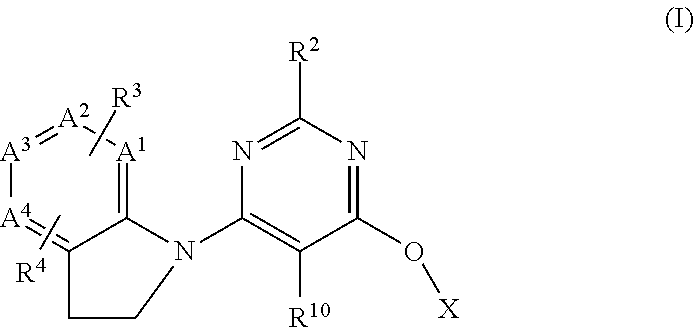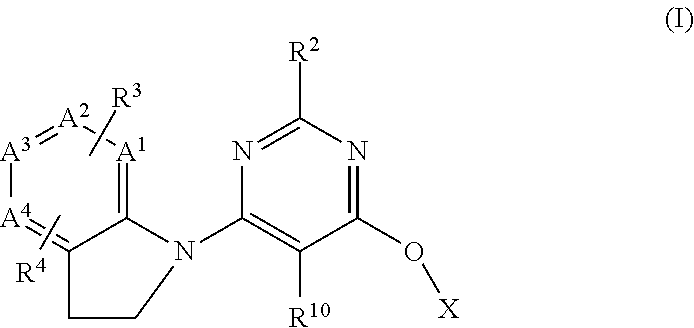GPR 119 modulators
a gpr 119 and modulator technology, applied in the field of gpr 119 modulators, can solve the problems of limited standard treatment of diabetes, no cure for diabetes, and insufficient investigation of the long-term effects of this broader effect, so as to stimulate weight loss and modulate the activity of the g-protein-coupled receptor
- Summary
- Abstract
- Description
- Claims
- Application Information
AI Technical Summary
Benefits of technology
Problems solved by technology
Method used
Image
Examples
example 1
Isopropyl 9-anti-({6-[5-(methylsulfonyl)-2,3-dihydro-1H-indol-1-yl]pyrimidin-4-yl}oxy)-3-oxa-7-azabicyclo[3.3.1]nonane-7-carboxylate
[0296]
[0297]Isopropyl 9-anti-hydroxy-3-oxa-7-azabicyclo[3.3.1]nonane-7-carboxylate (30 mg, 0.13 mmol) and 1-(6-chloropyrimidin-4-yl)-5-(methylsulfonyl)indoline (34 mg, 0.11 mmol) were dissolved in anhydrous 1,4-dioxane (1 mL). The brown mixture was heated at 105 degrees Celsius, and a 1 M solution of sodium bis(trimethylsilyl)amide in tetrahydrofuran (0.13 mL, 0.13 mmol) was added. The mixture was heated at 105 degrees Celsius for 1.5 hours, and then the mixture was allowed to cool to room temperature. The reaction was quenched with 10% aqueous phosphoric acid (0.5 mL). The organic solvents were concentrated under reduced pressure, and the resulting residue was partitioned between chloroform and water. The layers were separated, and the organic layer washed sequentially with water and brine and then dried over magnesium sulfate. The mixture was filtered...
example 2
Isopropyl 9-syn-({6-[5-(methylsulfonyl)-2,3-dihydro-1H-indol-1-yl]pyrimidin-4-yl}oxy)-3-oxa-7-azabicyclo[3.3.1]nonane-7-carboxylate
[0298]
[0299]This compound was prepared from isopropyl 9-syn-hydroxy-3-oxa-7-azabicyclo[3.3.1]nonane-7-carboxylate and 1-(6-chloropyrimidin-4-yl)-5-(methylsulfonyl)indoline in a manner similar to that described for Example 1. The crude product was purified via column chromatography (0-10% acetone in dichloromethane) to give isopropyl 9-syn-({6-[5-(methylsulfonyl)-2,3-dihydro-1H-indol-1-yl]pyrimidin-4-yl}oxy)-3-oxa-7-azabicyclo[3.3.1]nonane-7-carboxylate as a white solid (24% yield). 1H NMR (400 MHz, deuterochloroform) delta 1.27 (d, J=6.1 Hz, 6H), 1.96 (d, J=18.0 Hz, 2 H), 3.05 (s, 3H), 3.24 (d, J=13.7 Hz, 1H), 3.33 (m, 3H), 3.85 (d, J=11.2 Hz, 1H), 3.92 (d, J=11.4 Hz, 1H), 4.08-4.12 (m, 4H), 4.47 (d, J=13.9 Hz, 1H), 4.63 (d, J=13.4 Hz, 1H), 4.98 (m, 1H), 5.36 (br. s., 1H), 6.08 (s, 1H), 7.73 (s, 1H), 7.80 (d, J=8.4 Hz, 1H), 8.51 (s, 1H), 8.59 (d, J=8.4 H...
example 3
Isopropyl 4-({6-[5-(methylsulfonyl)-2,3-dihydro-1H-indol-1-yl]pyrimidin-4-yl}oxy)piperidine-1-carboxylate
[0300]
[0301]This compound was prepared from isopropyl 4-hydroxypiperidine-1-carboxylate and 1-(6-chloropyrimidin-4-yl)-5-(methylsulfonyl)indoline in a manner similar to that described for Example 1. This compound was purified by column chromatography (1:1 dichloromethane in acetone) to give a dark tan solid which was further purified via heating in methyl ethyl ketone. Upon cooling to room temperature, the mixture was diluted with methyl tert-butyl ether followed by filtration. The collected material was washed with methyl tert-butylether and then dried under vacuum to give isopropyl 4-({6-[5-(methylsulfonyl)-2,3-dihydro-1H-indol-1-yl]pyrimidin-4-yl}oxy)piperidine-1-carboxylate (7.89 g, 60%) as a white solid. 1H NMR (500 MHz, deuterochloroform) delta 1.27 (d, J=6.1 Hz, 6H), 1.70-1.80 (m, 2H), 1.97-2.07 (m, 2H), 3.05 (s, 3H), 3.28-3.38 (m, 2 H), 3.33 (d, J=8.8 Hz, 2H), 3.78-3.89 (...
PUM
| Property | Measurement | Unit |
|---|---|---|
| Volume | aaaaa | aaaaa |
| Molar density | aaaaa | aaaaa |
| Molar density | aaaaa | aaaaa |
Abstract
Description
Claims
Application Information
 Login to View More
Login to View More - R&D
- Intellectual Property
- Life Sciences
- Materials
- Tech Scout
- Unparalleled Data Quality
- Higher Quality Content
- 60% Fewer Hallucinations
Browse by: Latest US Patents, China's latest patents, Technical Efficacy Thesaurus, Application Domain, Technology Topic, Popular Technical Reports.
© 2025 PatSnap. All rights reserved.Legal|Privacy policy|Modern Slavery Act Transparency Statement|Sitemap|About US| Contact US: help@patsnap.com



